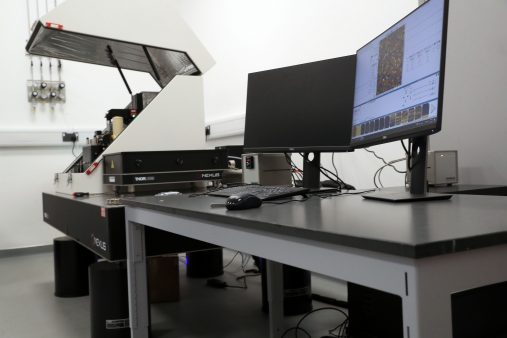First Images of Pollutant Nanoplastics
16 May 2022
Researchers at Cardiff University’s new Nanoscale Vibrational Spectroscopy (NVSI) research centre have used Photo Included Force Microscopy (PiFM) to produce the first ever images of pollutant nanoplastics. These images are not only the first of their kind in the world but also represent the first data collected from Cardiff University’s new Translational Research Hub (TRH). Here, Dr Josh Davies-Jones provides an overview.
 Plastic pollution poses a huge threat to our ecosystems and human health. Despite this, 99% of plastic pollution is still unlocated. Nanoplastics are a family of plastic pollutants which are made from the breaking down of larger plastic debris and have been discovered in drinking water, food and even the human placenta. These plastics can act as “sponges,” absorbing pollutants from the environment and delivering them into organisms like fish, which eventually can end up on our plate.
Plastic pollution poses a huge threat to our ecosystems and human health. Despite this, 99% of plastic pollution is still unlocated. Nanoplastics are a family of plastic pollutants which are made from the breaking down of larger plastic debris and have been discovered in drinking water, food and even the human placenta. These plastics can act as “sponges,” absorbing pollutants from the environment and delivering them into organisms like fish, which eventually can end up on our plate.
Nanoplastic materials are incredibly hard to study. They are less than 1000 nanometres in size, which is 70 times smaller than the width of a human hair: the size of such pollutants means they are particularly difficult to find and image.
While these plastics are a significant concern for our future, little research has focused on this field due to these difficulties. The use of PiFM changes this. PiFM is not only able to find and highlight plastic particles, but it can also indicate to us the source of these materials.
We can now study these tiny surfaces and their chemistry by capturing images of both the shapes of nanoplastics and locations of absorbed pollutants. PiFM achieves this by measuring the intensity of different bonds present within a chemical stuck to the surface which act as a fingerprint that can then be mapped across the particle.
The researchers have explored how the world’s most popular weedkiller, glyphosate, sticks to commonly-used plastics such as polypropylene and polyester. These images confirm the presence of glyphosate on the surface of polypropylene, and show the weedkiller may stick to certain areas more than others.
 These images tell us that pollutants like glyphosate adheres to the surface of plastic unevenly. Areas of the particle clearly preferred by the pollutant, and we would theorise that these preferred areas of the plastics have been degraded in different ways, leaving a range of chemical groups on the surface. Some of these will act as better anchors than others.
These images tell us that pollutants like glyphosate adheres to the surface of plastic unevenly. Areas of the particle clearly preferred by the pollutant, and we would theorise that these preferred areas of the plastics have been degraded in different ways, leaving a range of chemical groups on the surface. Some of these will act as better anchors than others.
These favourable areas could be a result of how the polymer backbone of polypropylene is broken, resulting in some areas of the plastic being richer in chemical groups which attract chemicals like glyphosate. Our research team has recently obtained funding from the Natural Environment Research Council and the Engineering (NERC) and Physical Sciences Research Council (EPRSC) to continue this work.
Our new home, the Translational Research Hub, based on Cardiff Innovation Campus, houses the CCI’s existing benchtop, tungsten and field emission SEMs alongside its Transmission electron microscopy (TEM) and brand-new aberration corrected advanced Scanning Transmission Electron Microscope (AC-STEM), a Cardiff first, reported on late last year.
These advanced microscopes will be coupled with a suite of sample preparation tools including ion milling, sectioning and coating systems to form the CCI Electron Microscopy Facility (CCI-EMF) aimed at delivering high-resolution imaging to a broad base of users.